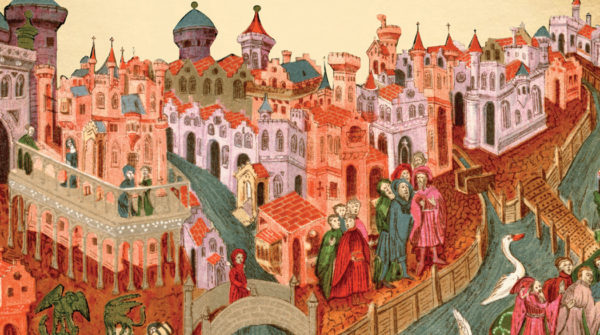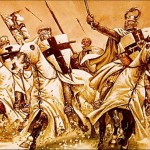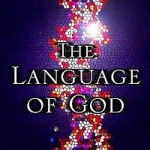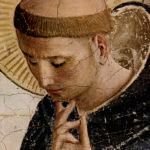The Idea of Progress: A Comparative Study
by Tamer Nashef
Filed under History

The pre-eminence of progress in the history of ideas and of Western civilization in particular cannot be overstated. This vastly important idea essentially means that the trajectory of human history is linear and forward-directed rather than cyclical or regressive. It holds that each generation advances beyond its predecessor and, therefore, the human condition improves over time amid the accumulation of scientific and technological knowledge. We tend to take the idea of progress for granted, but it has eluded many cultures. American-born British classical scholar Moses I. Finley maintains that it was unique to the West:
“We must remind ourselves time and again that the European experience since the late Middle Ages in technology, in the economy, and in the value systems that accompanied them, was unique in human history [my emphasis] until the recent export trend commenced. Technical progress, economic growth, productivity, even efficiency have not been significant goals since the beginning of time. So long as an acceptable life-style could be maintained, however that was defined, other values held the stage.” (147)
The assumption that the course of history was progressive and the confidence that great advances beckoned are reckoned to have played a key role in enabling the West to outstrip other civilizations from the late Middle Ages onward. Rodney Stark, American sociologist of religion, identifies the idea of progress as one of the factors “essential to the rise of the West” (How the West Won 33).
Conventional scholarly wisdom holds that the roots of this idea are firmly embedded in the 18th-century Enlightenment movement whose luminaries included Voltaire (1694-1778), Denis Diderot (1713-1784), Immanuel Kant (1724-1804), Adam Smith (1723-1790), and Baron d'Holbach (1723-1789) to name but a few. Enlightenment thinkers sought to emancipate mankind from what they perceived as the fetters of superstition and ignorance, and valued free inquiry and rational thought above tradition and custom. They viewed man as an essentially rational and reason-guided individual, and believed that the application of reason could solve all problems. They expressed confidence that the cumulative acquisition of knowledge led not only to a better understanding and growing mastery of the world but to its improvement as well. Anti-clericalism was one of the hallmarks of Enlightenment thought, as the philosophers of this age, such as Pierre Bayle (1647-1706), showed hostility toward organized religion and religious dogma.
Indeed, an outburst of optimism in the progressive course of mankind was one of the characteristic features of the Enlightenment. In A Digression on the Ancients and Moderns, French writer Bernard de Fontenelle (1657-1757) affirmed that progress and knowledge were “cumulative” and rejected “unreasoning admiration” for the ancients as an obstacle to progress (Watson 546-7). Another Frenchman Marquis de Condorcet (1743-1794) asserted his confidence in the “perfectibility of man,” adding that “nature has assigned no limit to the perfecting of the human faculties” (547). French social reformer Count Claude Henri de Saint-Simon (1760-1825) proclaimed that a “golden age is not behind us, but in front of us...Our fathers have not seen it; our children will arrive there one day, and it is for us to clear the way for them” (549). Lastly, German philosopher Georg Wilhelm Friedrich Hegel (1770-1831) viewed historical developments and changes in reality as manifestations of the progression of World Spirit toward the Absolute, and stressed that as part of the evolution of this Universal Spirit, freedom expanded over time, culminating in 19th-century Prussia (548).
So far so good. But is Enlightenment thought really the source of the idea of progress? Or can its origin be traced as far back as Medieval Christianity, particularly Catholicism (which Enlightenment philosophers loathed so much)?1 As early as the fifth century, St. Augustine (354-430), who “was to prove the most influential of all Christian philosophers” (Kenny 104), believed in theological progress in the sense that believers’ understanding of God’s will and of the biblical text increased with the passage of time. Though there were "certain matters pertaining to the doctrine of salvation that we cannot yet grasp,” he noted, “one day we shall be able to do so" (Stark’s Victory of Reason 9). In the same spirit, Augustine assured his friend that he would eventually gain understanding of those aspects of Christianity that had hitherto appeared incomprehensible or contradictory:
“Dispute not by excited argument those things which you do not yet comprehend, or those which in the Scriptures appear...to be incongruous and contradictory; meekly defer the day of your understanding” (Durant 70).
The North African theologian and philosopher could hardly restrain his excitement about material and scientific progress as well, extolling the "skill [that] has been attained in measures and numbers! With what sagacity have the movements and connections of the stars been discovered!" (Stark’s Victory 10). He pointed out human capacity for invention and lauded technological, agricultural, architectural, and nautical advances, saying:
"Has not the genius of man invented and applied countless astonishing arts, partly the result of necessity, partly the result of exuberant invention, so that this vigour of mind . . . betokens an inexhaustible wealth in the nature which can invent, learn, or employ such arts. What wonderful — one might say stupefying — advances has human industry made in the arts of weaving and building, of agriculture and navigation!" (9-10).
But Augustine was not a voice in the desert. Other Christian theologians and scholars shared his enthusiasm about human ingenuity and progress. 13th-century Gilbert de Tournai wrote:
"Never will we find truth if we content ourselves with what is already known. . . . Those things that have been written before us are not laws but guides. The truth is open to all, for it is not yet totally possessed" (10).
In the next century, Fra Giordano said in Florence: "Not all the arts have been found; we shall never see an end to finding them. Every day one could discover a new art." No wonder that Scottish philosopher John Macmurray (1891-1976) pinpointed Christianity as the fountainhead of the pervasive belief in progress: "That we think of progress at all shows the extent of the influence of Christianity upon us" (9).
Certainly, Christianity, particularly Catholicism, is a forward-leaning religion which embraces a linear, directional, and teleological conception of history.2 The Catholic worldview is predicated on the premise that history moves forward toward a definite goal or telos rather round in endlessly repeated circles. The optimistic Christian confidence in perpetual progress and the idea that matters ought to get better are said to have spurred the Western quest for new technology and facilitated the rapid and widespread adoption of new inventions. Indeed, Medieval Europe witnessed many agricultural and technological inventions such as eyeglasses, mechanical clocks, the printing press, the crop-rotation system, chimneys, the horse collar, etc., but these breakthroughs did not arouse the suspicion or elicit the opposition of the church. On the contrary, the Catholic Church, as the most dominant and powerful authority in Europe at the time, fully welcomed and adopted these inventions. As Stark argues,
“[a]ll these remarkable developments can be traced to the unique Christian conviction that progress was a God-given obligation, entailed in the gift of reason. That new technologies and techniques would always be forthcoming was a fundamental article of Christian faith. Hence, no bishops or theologians denounced clocks or sailing ships – although both were condemned on religious grounds in various non-Western societies. Rather, many technical innovations probably were made by monks and were eagerly adopted by the great monastic estates” (Victory 48).
In addition, Christian faith in theological progress has made the Medieval Catholic Church relatively flexible, enabling it to revise established doctrines so as to accommodate Christianity with developments and changes over time, especially in economy. While early Christian theologians may have had some misgivings about the pursuit of profit and the lending of money at interest, the successful economic activities of monastic orders from the 9th century forward, some of which functioned as banks, compelled later theologians to reappraise church positions on these issues. “Christian theology,” as Stark puts it,
“has never crystallized. If God intends that scripture will be more adequately grasped as humans gain greater knowledge and experience, this warrants continuing reappraisal of doctrines and interpretations. And so it was” (Victory of Reason 63).
Moreover, Christian suppositions about progress may have prompted Western theologians and scholars to legitimize and even insist on the adoption of useful knowledge, even that stemming from foreign, non-Christian cultures. English scholar Adelard of Bath (1080-1152), renowned for his dogged pursuit of learning in far-off places, especially the Middle East, called for keeping an open mind when it came to the acquisition of knowledge:
“It will be worthwhile to approach teachers of different people, to commit to memory what you may find is most finely expressed among each of them. For what the French studies are ignorant of, those across the Alps will unlock; what you will not learn amongst the Latins, eloquent Greece will teach you” (Lyons 2).
Despite Muslim-Christian enmity prevalent at the time, he had no qualms about acknowledging his debt to the “Arab masters” (124). Expressing the same sentiments, Daniel of Morley (1140-1210) wrote of his eagerness to become acquainted with Arab scholarship:
“But when I heard that the doctrine of the Arabs...was all the fashion in Toledo in those days, I hurried there as quickly as I could, so that I could hear the wisest philosophers of the world” (156).
As for the ancient Greeks, he wrote the following:
“Let us then borrow from them and, with God’s help and command, rob the pagan philosophers of their wisdom and eloquence. Let us take from the unfaithful so as to enrich ourselves faithfully with the spoils” (157).
12th-century translator Hugh of Santalla called for learning from the Arab scholars, lauding them as “our teachers and precursors” (157). His namesake and contemporary Hugh of Saint Victor (1096-1141) advised his students to accept all forms of knowledge: "Learn willingly what you do not know from everyone. The person who has sought to learn something from everyone will be wiser than them all. The person who receives something from everyone ends by becoming the richest of all" (Pope Benedict XVI 220). In the same century, the great rationalist Peter Abelard (1079-1142) ruled out the existence of harmful knowledge, arguing that “[a]ll knowledge is good, even knowledge of evil” (Huff 141).
The discussion on Christianity’s progressive view of history warrants a comparison with that of the ancient Greeks, Romans, the Chinese, and Muslims. While Christian theologians conceived of history in terms of progress and upward movement, their ancient Greek predecessors believed existence was subject to ineluctable and eternal cycles. In other words, the idea of historical progress would have been alien to the Greek temperament. In contrast to Christianity’s teleological conception of existence, history for the ancient Greeks was devoid of ultimate purpose or end; a golden age was inexorably bound to give way to decline (and vice versa).3 The great Greek philosopher Aristotle (384-322 BC) posited an uncreated and eternal universe, charged that "the same ideas recur to men not once or twice but over and over again”, adding that everything had "been invented several times over in the course of ages, or rather times without number” (Victory 19). Aristotle’s political theory was also heavily influenced by the concept of the cyclical flow of time prevalent in Greece. Thomas I. Cook opines that Aristotle’s
“observations convinced him that all of the simple, good forms of government which he had described sooner or later changed into their corresponding corruption, and that out of this arose an endless series of revolutions, so that the balance was never attained [my emphasis]. For it is clear to him that the germs of revolution are in the very principle of the various forms, and from his knowledge of Greek history he outlined a theory of regular change. This is the celebrated cyclical theory of history [my emphasis], and for Aristotle it goes on with an unchanging radius and endless succession. Each form of city-state brings the new form that necessarily springs from it in terms of human motivation. The circle never expands and is never broken. Thus it lacks any real development, is a closed system [my emphasis]” (121).
Zeno of Citium (334–262 BC), founder of the Stoic school of philosophy, held, in the words of 20th-century British philosopher Bertrand Russell, that “[e]very thing that happens has happened before, and will happen again, not once, but countless times” (254). Indeed, according to the Stoics, the "difference between former and actual existences of the same people will be only extrinsic and accidental; such differences do not produce another man as contrasted with his counterpart from a previous world-age” (Stark’s Victory 19). Roman Emperor Marcus Aurelius, who ruled for 20 years until his death in 180 AD and who professed Stoicism, believed that the virtuous soul had the ability to “reach out into eternity, embracing and comprehending the great cyclic renewals of creation, and thereby perceiving that future generations will have nothing new to witness” (Morris 21). The idea of circularity figures prominently in the cosmology of pre-Socratic philosopher Empedocles (495-430 BC), who stated that Love and Strife dominated the four fundamental elements (earth, air, fire, water) making up the complex substances. For Empedocles,
“[t]here were periods when Love was in the ascendant and others when Strife was the stronger. There had been a golden age when Love was completely victorious. In that age, men worshipped only the Cyprian Aphrodite. The changes in the world are not governed by any purpose, but only by Chance and Necessity. Every compound substance is temporary; only the elements, together with Love and Strife, are everlasting. There is a cycle: when the elements have been thoroughly mixed by Love, Strife gradually sorts them out again; when Strife has separated them, Love gradually reunites them. Thus every compound substance is temporary; only the elements, together with Love and Strife, are everlasting” (Russell 55).
Another pre-Socratic philosopher, the famous Pythagoras (570–495 BC), taught, according to Dikaiarchos, that "whatever comes into existence is born again in the revolutions of a certain cycle, nothing being absolutely new" (32). Followers of Orpheus, a Thracian reformer of the religion of Bacchus and a poet whose music was said to have moved inanimate objects, conceived of earthly life as “pain and weariness,” and believed
“[w]e are bound to a wheel which turns through endless cycles of birth and death [my emphasis]; our true life is of the stars, but we are tied to earth. Only by purification and renunciation and an ascetic life can we escape from the wheel and attain at last to the ecstasy of union with God” (21).
St. Augustine broke with these ancient Greek assumptions about time and history. As a Christian, he professed that the world had been created at a definite or particular time and would end at an unknown date in the future. Thus, he repudiated the doctrine of cyclical time and of an eternal universe, charging that “deceiving and deceived sages” were behind it (Morris 24). Rejecting the eternal recurrence of events, Augustine stressed that “once Christ died for our sins; and, rising from the dead, He dieth no more” (24). Indeed, the idea that Christ would be endlessly crucified and resurrected would have been anathema to Christian theologians.
For their part, the Romans were rather conservative, tradition-bound, and oriented to the past. They believed that the way to progress entailed a return to a past golden age4 and strict adherence to established tradition. Therefore, they viewed innovation with suspicion, regarding it as dangerous and subversive. This is why they were quite respectful of old religions like Judaism but suspicious of religions like Christianity that broke away from its parent faith (Armstrong 91). This suspicion to innovation did not escape the notice of Roman poet Horace (65-8 BC) who in his Epistles wondered: “Had the Greeks held novelty in such disdain as we, what work of ancient date would now exist?” (Davies 150). The Romans sought to emulate the ancient Greeks (especially in literature), and broadly speaking, rarely moved beyond them, fostering “the very notion of the classics, the idea that the best that had been thought and written in the past was worth preserving and profiting from” (Watson 199). Is it possible that the Romans’ backward-oriented outlook was one of the one reasons for the absence of significant scientific advances during Roman times?5 A number of Latin authors (such as Varro, Seneca, Pliny the Elder) did compile encyclopedias summarizing scientific knowledge to date. However, other than these large compilations, Roman civilization achieved little by way of science. In their magisterial Science and Technology in World History, McClellan and Dorn assess that
“there was little Roman science. Very little Greek science was ever translated into Latin. For the sake of tradition, Roman emperors patronized the Museum in faraway Alexandria...Some privileged young Romans learned Greek and toured and studied in Greece. But Rome itself produced no Roman scientist or philosopher of the first or second rank” (106).
Like the Romans, the Chinese asserted the superiority of the past and of traditional wisdom as evidenced by 12th-century high public official Li Yen-Chang’s view that "[i]f scholars are made to concentrate their attention solely on the classics and are prevented from slipping into study of the vulgar practices of later generations, then the empire will be fortunate indeed!" (Stark’s Victory 10). They also lacked an understanding of time as linear or progressive. Rather, the Chinese outlook stipulated that the universe, conceived as a single organism, was subject to recurring cycles in which dominance alternated between two great forces, the yin and yang, and the five elements (water, fire, earth, metal, wood) (McClellan and Dorn 147-8).
Certainly, the Chinese built a magnificent civilization that gave birth to many superb inventions, especially gunpowder, the mechanical clock, woodblock printing and moveable type, paper, paper money, the magnetic compass, the seismograph, the spinning wheel, the silk reeling frame, the seed drill, etc. As stated previously, the Christian commitment to progress gave stimulus to the West’s embrace of new inventions. In contrast, Chinese conformism along with resistance to change, deep-seated respect for tradition, and suspicion toward innovation, may have kept Chinese civilization from building upon its initial (indeed impressive) advances and from breaking through to modern science.
For example, the talented engineer Liang-Ling Tsan invented around 725 AD the mechanical escapement, “the key regulating device in all mechanical clocks” (McClellan and Dorn 152). This spawned a tradition of mechanical and planetarium tradition, reaching its apex at the end of the 11th century with the construction of a mechanical astronomical clock tower designed by Su Song (1020-1101), “an impressive feat of mechanical engineering and the most complex piece of clockwork to that point in history” (153). However, after Su Song’s death, the Chinese failed to preserve the knowledge and expertise required to duplicate the construction of this sophisticated contrivance, so much so that they were astounded by Western clocks when they first made an appearance in 17th-century China (152). In another version of how this invaluable mechanical knowledge was lost, Stark notes that “the hostility of the Mandarins [high public officials or bureaucrats] toward mechanical contrivances was so great that they soon ordered them destroyed, and no clocks existed in China again until modern times” (Victory 44). Regardless of whether it was indifference or outright hostility that caused the disappearance of mechanical clocks, the Chinese backward-oriented worldview and fear of innovation may have stunted scientific and technological progress and blocked the path to a scientific revolution that eventually unfolded in the West and nowhere else.
Similarly, the discovery of the compass and the application of gunpowder to military ends helped transform China into the greatest navy on earth, culminating with the seven sea expeditions led by the Muslim sailor Zheng He. These expeditions, which took place between 1405 and 1433 under emperor Yongle, reached as far as the Persian Gulf, the Red Sea, and the coast of East Africa, winning in the process a number of vassal states and asserting the political dominance of the Ming Dynasty (1368-1644). “Then, abruptly,” recount McClellan and Dorn,
“the extraordinary maritime thrust of the Ming came to an end. Official shipbuilding ceased in 1419, and a decree of 1433 put an end to further Chinese overseas expeditions. No one can say whether the course of world history would have been radically different had the Chinese maintained a presence in the Indian Ocean and rebuffed the Portuguese when they arrived with their puny ships at the end of the same century” (146).
The empire issued the haijin decrees banning oceanic voyages, and as Scottish historian Niall Ferguson points out, from 1500 forward, “anyone in China found building a ship with more than two masts was liable to the death penalty; in 1551 it became a crime even to go to sea in such a ship. The records of Zheng He’s journeys were destroyed” (32). The Chinese authorities had decided to turn inward and to abandon their overseas ambitions. Ming China had adopted an isolationist policy, with Chinese science and technology entering a period of decline. Historians have put forward a number of explanations for the sudden turn of events, one being ingrained Confucian suspicion of novelties and fear they might disrupt the social order or status quo.
Lastly, it appears there are two divergent traditions regarding the interpretation of history in Islamic civilization, one Sunni and another Shiite. Like the Romans and Chinese, the Sunnis “have tended to see Islamic history as a gradual movement away from the ideal community [my emphasis], which existed during the life of Muhammed and his four immediate successors” (Heywood 298). In other words, the Sunnis have a propensity to idealize the past and to believe that imitating it and holding fast to their legalistic traditions are key to reenacting past glories.6 Other Sunni traditions seem to emphasize the cyclical nature of history. In his famous Muqadimah (Prolegomenon), the North African historiographer Ibn Khaldun (1332-1406) examines the rise and fall of dynasties, espousing a cyclical model of historical movement. Commenting on Ibn Khaldun’s theory of history, Dan Diner states: “In his work, there is no shortage of assertions such as that the past resembles the future as one drop of water resembles another” (161-2).
The Shiite worldview, however, is fundamentally different; while Sunnis tend to be backward-oriented in their understanding of history or to see history as moving in cycles, the Shias are oriented to the future. In the words of one scholar, they “see history moving toward the goal of an ideal community, not away from it” (Heywood 298). Put differently, the Shias seem to believe the best lies ahead rather than lies buried in the past. The 10th-century Fatimid Shiite dynasty, which took power in Tunisia and Egypt and set up the city of Cairo, saw its rule “not as a return to the good old days of early Islam, but as the progressive unfolding of a new era in cosmic history” (Black 46).7 Striking the same chord, the 10th-century Shiite scholars Ikhwan al-Safa (Brethren of Purity) devised a theory of history according to which “each Prophet-legislator-Imam ushers in a new epoch, characterized by its own philosophy, religion, language and science. Each builds on the last; translation is therefore essential, and pre-Islamic belief systems retain some significance” (61).
Contrary to prevailing opinion, philosophy, which suffered a major setback in the Sunni tradition after Ibn Rushd (known as Averroes in the Latin tradition, 1126-1198), continued to exist and even flourish in Shiite domains for centuries after Islamic civilization’s rationalist and scientific heritage is believed to have atrophied.8 During Medieval times, most Sunni religious colleges persistently excluded the study of Greek philosophy and science from their curricula and focused instead on the religious sciences (Koranic exegesis, hadith, Arabic grammar) – a trend that persisted well into modern times (until the Arab Renaissance of the 19th century). By contrast, the Greek (and other non-Islamic) philosophical and scientific tradition was integrated into programs of instruction at Shiite institutions of higher learning. In addition, Shiite imams not only legitimized but also encouraged the study of pre-Islamic learning inherited from the ancient Greeks or Zoroastrian Persians.9 It should come as no surprise then to learn that though a minority in Islam, a disproportionate number of the scientific and philosophical stars of the Islamic Golden Age were either Shias or affiliated with the Shiite doctrine, such as Jabir ibn Hayyan (721-815), Al-Farabi (died in 950), the 10th-century Ikhwan al-Safa (Brethren of Purity) group of scholars, Ibn Sina (980-1037), Al-Biruni (973-1048), Nasir al-Din al-Tusi, (1201-1274), Al-Jaldaki (died between 1349 and 1361), Baha’ al-Din al-‘Amili (1546-1621), etc. On these Sunni-Shiite differences, contemporary Persian philosopher and scientist Seyyed Hossein Nasr says:
“The Sunni madrasah was established essentially for the purpose of training students in the sacred law and other religious sciences; its program consisted primarily of the Quran, Hadith, exegesis, Arabic grammar and literature, law, theology and oratory (to which the study of philosophy and history, and a small amount of mathematics, were occasionally added). The Shiite schools, however, showed an affinity toward the awa’il [ancient Greek] sciences, placing a much greater emphasis in their program on these subjects” (72).
He adds:
“Certain schools of Greek philosophy and science, especially the more esoteric schools connected with Neopythagoreanism and Hermeticism, became integrated into the Shiite perspective at an early period, and some of the Shiite imams legitimized the study of the awa’il sciences and even encouraged it. The Sunni lawyers and jurisprudents, however, for the most part remained aloof from these sciences and, in fact, often opposed them. They usually accepted only Aristotelian logic, which thereby became an accredited discipline and aided discussions – on questions of law and theology, and even grammar...The Sunni schools were in general more inclined toward the study of law and theology, and the Shiites to the sciences of Nature and mathematics, although many Sunni rulers and princes cultivated these sciences on their own” (72).
Works Cited
Armstrong, Karen. A History of God: The 4,000-Year Quest of Judaism, Christianity and Islam. Ballantine Books, 1993.
Black, Antony. The History of Islamic Political Thought: From the Prophet to the Present. 2nd ed., Edinburgh University Press, 2011.
Cook, I. Thomas. History of Political Philosophy: From Plato to Burke. Prentice-Hall, Inc., 1936.
Davies, Norman. Europe: A History. Pimlico, 1997.
Diner, Dan. Lost in the Sacred: Why the Muslim World Stood Still. Translated by Steven Rendall, Princeton University Press, 2009.
Durant, Will. The Age of Faith: A History of Medieval Civilization – Christian, Islamic, and Judaic – From Constantine to Dante: A.D. 325-1300. Simon and Schuster, 1950.
Ferguson, Niall. Civilization: The West and the Rest. Penguin Books, 2011.
Finley, I. Moses. The Ancient Economy. 3rd ed., University of California Press, 1999.
Goiten, S. D. Jews and Arabs: Their Contacts Through the Ages. 6th ed., Schocken Books, 1964.
Grant, Edward. The Foundations of Modern Science in the Middle Ages: Their Religious, Institutional, and Intellectual Contexts. Cambridge University Press, 1996.
-------------------. Science and Religion 400 BC- AD 1550: From Aristotle to Copernicus. The John Hopkins University Press, 2004.
Grieve, Paul. A Brief Guide to Islam: History, Faith And Politics: The Complete Introduction. Robinson, 2006.
Heywood, Andrew. Political Ideologies: An Introduction. 5th ed., Palgrave Macmillan, 2012.
Huff, Toby. The Rise of Early Modern Science: Islam, China and the West. 2nd edition. Cambridge University Press, 2003.
Kenny, Anthony. A Brief History of Western Philosophy. Blackwell Publishers, 1998.
Lyons, Jonathan. The House of Wisdom. Bloomsbury, 2010.
McClellan, E. James, and Harold Dorn. Science and Technology in World History: An Introduction. 3rd ed., John Hopkins University Press, 2015.
Morris, Richard. Time's Arrows: Scientific Attitudes Toward Time. Simon & Schuster Inc., 1987.
Nasr, Hossein Seyyed. Science and Civilization in Islamic Civilization. 2nd ed., The Islamic Texts Society, 1987
Nisbet, A. Robert. History of the Idea of Progress. 4th ed., Transaction Publishers, 2009.
Pope Benedict XVI. Great Christian Thinkers: From the Early Church Through the Middle Ages. Society for Promoting Christian Knowledge, 2011.
Russell, Bertrand. The History of Western Philosophy. 2nd ed., Simon & Schuster, 1972.
Stark, Rodney. How the West Won: The Neglected Story of the Triumph of Modernity. ISI Books, 2014.
------------------. The Victory of Reason: How Christianity Led to Freedom, Capitalism, and Western Success. The Random House Publishing Group, 2005.
Watson, Peter. Ideas: A History of Thought and Invention, From Fire to Freud. Harper Perennial, 2005.
Related Posts
Notes:
- For the sake accuracy, it is noteworthy that Judaism sustains a linear conception of history as well, and, as Robert A. Nisbet argues, “[n]othing in the history of the idea of progress is more important than” the Christian embrace and universalization of Jewish millenarianism (49). On the Jewish understanding of history, Richard Morris says: “Judaism was unique among the religions of the ancient world in that it placed an emphasis on unique historical events that were supposed to have taken place at particular points in time. The Exodus from Egypt, for example, was something that had happened only once. It was a specific event that had an important religious significance. Similarly, God had made his promises to Abraham on a specific occasion, and He had given the Law to Moses at a particular time. History, in ancient Judaism, was an arena in which God’s purposes were fulfilled. It would have been practically blasphemous to suggest that historical events were repeated in endless cycles.
“The concept of cyclical time was not unknown to the ancient Jews. We read in the book of Ecclesiastes, ‘The thing that hath been, it is that which shall be; and that which is done is that which shall be done; and there is no new thing under the sun.’ However, references to such ideas are encountered infrequently in the Old Testament. The emphasis is on the working out of God’s purpose in a linear time that began with the Creation” (22-3).
- The idea of progress did not penetrate Orthodox/Eastern theology. As Stark notes, “the Eastern Orthodox hierarchy refused to permit any mechanical clocks in their churches until the twentieth century” (Victory 44). Eminent historian of science Edward Grant underlines the “overwhelmingly backward looking” character of Byzantine/Orthodox scholarship (Science and Religion 228). Byzantine scholars viewed the work of their ancient Greek antecedents as the culmination of human knowledge and had no confidence in their ability to add anything of value to that legacy. Fourteenth-century scholar Theodore Metochites spoke for many when he charged that “[t]he great men of the past have said everything so perfectly that they have left nothing for us to say” (228). Such a state of mind is hardly conducive to the production of original work. No wonder that Grant labels Byzantine scholarly work as “formalistic,” “pedantic,” “rarely innovative,” “unremarkable,” and “uncritical” (Foundations 190, 191).
- Cyclical conceptions of time dominated the thought of almost all ancient civilizations. Babylonian priest Berossos (who migrated to the Greek island of Cos in 290 or 270 BC) taught that “the world would periodically be destroyed, and then created anew, at periodic intervals, when all the stars came together in the constellation of the Crab. Each re-creation would mark the beginning of a new Great Year, during which terrestrial events would parallel those of the Great Year that had just ended. According to this doctrine, terrestrial events exhibited cyclic patterns that paralleled those which could be seen in the heavens” (Morris 17). Likewise, Indian philosophers, particularly of the Vedic period (1500-600 BC), “conceived of cycles within cycles. The smallest was an age, which measured about 360 years; the longest corresponded to the lives of the gods, which were thought to be of the order of 300 trillion years. But time would not come an end, not even after those trillions of years had passed. The gods themselves would die and be reborn, and the cosmic cycles of creation and destruction would go on forever” (21). Similar ideas appeared in Aztec and Mayan civilizations, as well as in Norse mythology (22).
- Roman poet Ovid (43 BC –17/18 AD) postulated a past golden age in which peace, security, and morality prevailed, so much so that no laws were needed to restrain potential violence or armies to fight wars: “With no one to impose punishment, without any laws, men kept faith and did what was right...The people passed their lives in security and peace, without need for armies” (Watson 92).
- Though weak in science, the Romans were “the greatest technologists and engineers of the ancient world” (McClellan and Dorn 106). They developed military and naval technologies, built extensive roads and aqueducts, and used the wedge arch in the construction of buildings and bridges. Their arguably greatest achievement, however, is the invention of cement (106). To the Romans also goes the credit for coming up with the idea of republicanism or representative democracy (Watson 199). Furthermore, the Western legal tradition draws heavily on Roman law, “the most influential aspect of Roman thought” (202).
- The decision of Ottoman Sultan Beyazid to ban the printing press as early as 1485 (his successor Selim I consolidated the decree in 1515) indicates that the Sunni tradition was overall resistant to change and innovation, especially from the late Middle Ages forward. This ban remained in force in Ottoman lands, except for a brief duration from 1728 through 1745, into the early 19th century. There were of course great Sunni scholars as names such as Ibn Rushd, Ibn Khaldun, Ibn Tufayl (died in 1185), Ibn Bajja (Avempace in Latin, died 1138), Ibn al-Haytham (Alhazen in Latin, 965-1040), and Abu-al-Qasim al-Zahrawi (936-1013), illustrate only too well. Broadly speaking, however, philosophy and science remained peripheral to the mainstream of the Sunni intellectual tradition, which (unlike its Shiite counterpart) was largely impervious to the influence of Greek thought.
- The rational and natural sciences flourished under the auspices of Egypt’s Fatimid rulers as evidenced by great names such as Ibn Yunis (950-1009) in astronomy and Ibn al-Haytham in optics and mathematics. The Fatimid rulers were also tolerant of Christians, Jews, and Sunnis (Black 46), except during the reign of the whimsical Caliph Al-Hakim bi-Amr Allah (ruled from 996 to 1021) who toward the end of his life was given to bouts of rage and madness. The great Jewish historian S. D. Goitein hails the Fatimids as “the most liberal rulers of the Middle Ages,” noting that “[m]any Christians and Jews [under Fatimid rule] attained the highest government posts, while retaining their religion” (82).
- The Western public, unfortunately, continues to be unaware of great Shiite philosophers, who flourished in the Safavid era (1501-1722) in places like Isfahan and Shiraz, such as Sadr al-Din al-Dashtaki (died in 1498), Mir Damad (died in 1631 or 1632), Mir Findiriski (died in 1640), Mulla Sadra (died in 1640), Baha’ al-Din al-‘Amili (1547-1621), etc.
- In my view, the similarities between Catholicism and Shiite Islam have been ignored for too long. One striking similarity is that just as Catholics incorporated pagan elements into their theology, thereby creating a brilliant synthesis of Christian beliefs and Greek philosophical ideas, so did the Shias manage to combine core Islamic concepts with pre-Islamic wisdom, whether Zoroastrian or Greek. For more on these Shiite-Catholic parallels, see Paul Grieve’s A Brief Guide to Islam, 273-8.
Note: Our goal is to cultivate serious and respectful dialogue. While it's OK to disagree—even encouraged!—any snarky, offensive, or off-topic comments will be deleted. Before commenting please read the Commenting Rules and Tips. If you're having trouble commenting, read the Commenting Instructions.













